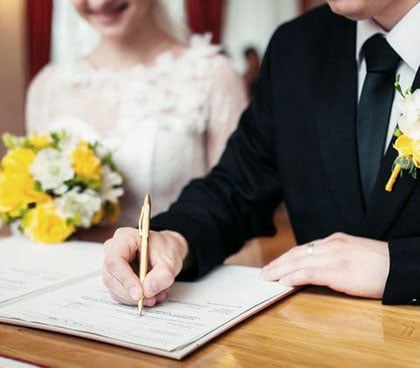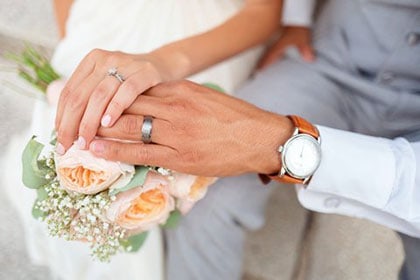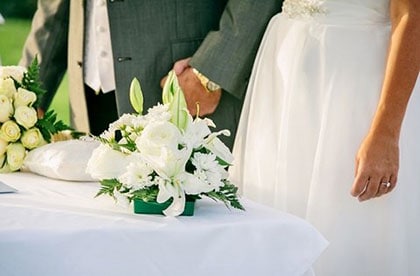
Jul 24
The necessary Documents by Civil Ceremony in the UK – Wedding Preparation
The Civil Ceremony and History of Marriage
The word ‘wedding’ comes from the Anglo-Saxon word wed, meaning a pledge (especially a financial one), and it is this pledge, in its modern form, that constitutes a marriage. For the marriage to be legal in this country it has to take the form of a public declaration, before at least two adult witnesses, that the couple intend to live together as husband and wife, and know of no reason legally why they are not free to marry. They must also fulfil the legal requirements in every respect.
In Church of England services these requirements are bound up in the wording of the marriage ceremony. In ceremonies held at registry offices or in churches of other denominations, both parties must make a public declaration in these or similar words: I do solemnly declare that I know not of any lawful impediment why I (full name) may not be joined in matrimony to (full name of partner)’. Then each must say: ‘I call upon these persons here present to witness that I (full name) do take (full name of partner) to be my lawful wedded wife/husband’.
In Church of England ceremonies, the vows taken before God are quite complex, involving the well-known phrases ‘for better, for worse, for richer, for poorer, in sickness and in health, till death us do part’. These are solemn vows, not to be undertaken lightly; if you do not feel that you can honestly take them it is better to choose a marriage in a registry office rather than be hypocritical. If you are getting married in an Anglican ceremony you will find that the vicar will probably offer you the choice of several different versions of the marriage service; some are traditional, some modern. Choose the type that best suits the kind of vows you want to make and the tone of your wedding in general. In some ceremonies both inside and outside the Anglican church it is possible to write your own vows, so that you can phrase them to emphasise the things you both feel will be important in your marriage. Generally, you will repeat the vows in small phrases after the minister, but it is possible to read your vows or to learn them, which can be very moving – but make sure that you have a crib sheet handy in case your mind goes blank!
Marriage Ceremony of the Ring
As well as the legal aspect of marriage in this country, and the words that need to be repeated publicly before the marriage is valid, there are various ceremonies that have grown up around the traditional exchange of vows. One is the ceremony of the ring; in most cases the groom gives a ring to the bride, and in some cases she also gives a ring to the groom. These are placed on the ‘ring finger’ with appropriate sentiments, varying from tradition to tradition.
Giving the Bride Tradition
Another ceremony is that of giving the bride away. Traditionally it is the bride’s father that performs this duty, a legacy of the times when marriages were financial contracts made for convenience rather than unions of love. The bride’s father accompanies her down the aisle before the ceremony, stands just behind her at the front of the church, and indicates his assent when the minister says ‘Who gives this woman to be married to this man?’ or similar words. If the bride’s father has died she can be given away by her uncle, brother, grandfather, godfather or family friend; the person chosen should be a man who is close to the bride’s family. If the bride has a stepfather it should still be her real father who gives her away if they are on good terms; if not, or if she rarely sees her real father, then the stepfather will probably be the best choice.
Kissing the Bride Tradition
Kissing the bride, no longer has the significance that it used to have, when it marked the first kiss the couple had exchanged! Nevertheless, some couples still include it, either as part of the ceremony or simply as an impulsive gesture when they are man and wife. If the minister knows the couple well he too may kiss the bride after the marriage, and so may the two fathers, but is extremely bad form for anyone else to kiss her before the groom has had the chance.
Traditions in Egypt Marriage
In Egypt the marriage contact used to be arranged between the groom and the bride’s deputy; they joined hands and the hands were then covered with a cloth to complete the union.
Traditions in Quaker Marriage
When a Quaker wedding takes place, the groom holds the bride’s hand and makes this declaration: ‘Friends, I take this, my friend (name of bride) to be my wife, promising, through Divine assistance, to be unto her a loving and faithful husband so long as we both on Earth shall live.’
Traditions in Jewish Marriage
There are three elements that compose a marriage under Jewish tradition. The first is the groom’s recitation of the wedding vow, an ancient Aramaic vow which when translated means ‘Behold thou art consecrated unto me with this ring according to the law of Moses and of Israel’; he recites this as he places the ring on his bride’s finger. The second element is the reading of the Ketubah, the legal marriage document which spells out the obligations and rights of the bride and groom. This is the Jewish equivalent of the marriage certificate, and is held as a treasured possession by the bride. And the said bride plighted her troth unto him, in affection and with sincerity, and has thus taken upon herself the fulfilment of all the duties incumbent upon a Jewish wife. This covenant of marriage was duly executed and witnessed this day according to the usage of Israel.
The third element that completes the marriage is the symbolic union, the Yihud. After the recessional the bride and groom retire into a private room for a short time, where they have some food together; this is often a special wedding broth.
Additional Marriage Traditions
Many traditions still have, in some form or another, a symbolic expression of reluctance on the part of the bride. This may take the form of actually running away, or may be something as symbolic as weeping when she leaves home for the last time; in Roman times the bride was symbolically torn from her mother’s arms. All these acts seem to date from the times when men went out hunting to capture a suitable bride from a neighbouring tribe or village.
In many North African marriages either the bride or the groom or both are painted with patterns of henna. These stain the skin and may last for up to several weeks before they wear off. Other traditions Hindu marriages can be very varied; in the laws of Manu, which form the basis of Hindu law, eight separate kinds of marriage are recognised, including marriage by purchase, by fraud, by rape and by consent. The most common form is by gift of the bride to the bridegroom from her father, without other obligations. The most important marriage ceremony consists of the bride and groom joining hands and taking seven steps, although in some traditions the only ceremony is a feast for the two families.
Amongst the ancient Kumi tribe the strange ceremony of marriage to a mongo tree exists. First the groom and then the bride is married to the tree and embraces it, and it is only after each partner has done this that they are considered man and wife.
The traditional wedding ceremony in Papua required the bride and groom to sit back to back in the middle of a hut, surrounded by the witnesses, while an old man joined their hands and then spat a mouthful of water over them. The Andaman Islands are populated by an aboriginal race that is considered one of the most primitive in the world. Their marriage ceremony, appropriately, is very simple: the bride is brought to an empty hut and sits down; the bridegroom pretends to run away but is brought to the hut also and made to sit on the bride’s lap. They are considered married. In an ancient ceremony from Finland the bride and groom each have to swallow a piece of fungus, used as tinder, that has been set alight.
In many Hindu traditions the bride must not speak to or see her groom until the ceremony is completed; in some areas she may even have her eyelids sealed down temporarily with a sticky substance. In ancient Bedouin tribes the girl runs away into the hills when the marriage time is appointed; the groom goes in search of her, and when he finds her they both stay out overnight in the hills. This constitutes the marriage. During traditional Druse weddings in the Middle East the groom would place a very elaborate pointed headdress on the bride’s head; this would then be worn by her night and day. In Persia marriage by proxy used to be the general rule; the bride did not need to be present until the actual consummation of the marriage.
The Order of Service Traditions
Most couples have an order of service specially printed for the wedding day; this saves the guests from having to riffle through hymnbooks, service books, etc., as all the necessary information is printed on the one sheet. Even if you are marrying in a traditional Church of England ceremony, there are still numerous variations you may want to make, and several decisions you will need to make regarding the details of the order of service.
Choosing the music will need to be done before you have the orders of service printed; you will probably want to put in the titles of the pieces you choose for before and after the ceremony, and during the signing of the register. In addition, you will almost certainly want some hymns; these should be printed out in full in the order of service sheets. Don’t feel obliged to have all the verses of your favourite hymns if you don’t want them, or if you want to cut down on the time; similarly, don’t be afraid to vary the tune if there is one that you prefer to the tune suggested by the hymnbook. Do try and choose at least one hymn that is very well known by all the congregation; If your choice is very obscure you might find yourselves doing a duet! You will need to sort out the exact order in which the elements of the service occur. Again the Anglican service has a fairly set order, but even this can be varied, for instance by changing when you have the prayers or readings(s), or how many hymns you have before the marriage itself. Most ministers prefer to have the marriage very near the beginning of the service, as most of the other elements prayer, blessing, address – are related to the couple as man and wife.
Ceremony Introduction and Arrangement of the Service Elements
Generally, the minister gives an introduction after the wedding party is assembled at the front of the church, and then a hymn is sung. The marriage usually takes place straight after the first hymn. The minister will fist the purposes of marriage, check the intentions of the bride and groom to be a good wife and husband, ask if there are any legal impediments to the marriage, and then supervise the exchange of vows and of rings. He will then declare the couple to be man and wife. The order of elements in the service may then be arranged according to your own preferences and the minister’s. He will offer up some prayers for you as a couple, and if you have a friend or friends whom you would like to pray for you publicly this too can be incorporated. Sometimes the bride and groom will choose to pray for one another publicly, asking God’s help as they go on in life as husband and wife.
The minister may give a short address, usually’ words of advice and well-wishing for the couple as they start married life. There are often one or two readings from the Bible; these may be read by the minister, by friends or relations, or by the couple themselves. Usually one or two more hymns are sung, and the religious part of the service is concluded before the wedding party goes into the vestry, as when they come out they will simply process through the church to the door.
The register is signed by the groom, the bride, the person who performed the wedding and two witnesses. It is best to choose the witnesses beforehand, to save everybody rushing when two are asked for; generally, it is the best man and the chief bridesmaid, but the choice could be both mothers, both fathers, or one representative from each family. The time during the signing of the register can be very boring for the wedding guests, so it is customary to have something going on in the church meanwhile, such as somebody singing or the organist playing a particular piece, or perhaps a friend playing a flute or violin solo. Whatever it is, try to print the details in the order of service sheet so that the guests know what is going on and whether they ought to be joining in.
Once you have decided on the details of the service, instruct your printer on what you want on your order of service sheets. These can be printed in the same style as your wedding invitations, although of course they will be more extensive. Print all the information that the guests will need, for instance when they are expected to join in with prayers or responses. Printing the music that the wedding party will enter and leave to will also make sure that the guests stand at the right time!
Suggestions for Music for the Ceremony
Frank Sinatra Classics □ Hello young lovers
□ Let’s fall in love
□ Somebody loves me
The Beatles No. 1 Singles □ Love me do
□ I want to hold your hand
□ Can’t buy me love
□ All you need is love
Various Artists □ Angels – Robbie Williams
□ Love is all around – Wet Wet Wet
□ l’ll never break your heart – Backstreet Boys
□ I love you always forever – Donna Lewis
□ One moment in time – Whitney Houston
□ If you don’t know me by now – Simply Red
□ Have I told you lately – Rod Stewart
□ How deep is your love – Bee Gees
□ It must be love – Madness
□ l’ll never fall in love again – Deacon Blue
□ Show me heaven – Maria McKee
□ Wonderful tonight – Eric Clapton
□ Romeo and Juliet – Dire Straits
□ Power of love – Jennifer Rush
□ Always on my mind – Elvis Presley
Suggestions for Poetry and readings □ I wanna be yours by John Cooper Clarke
□ Shall I compare thee to a summer’s day? (Sonnet 18) by William Shakespeare
□ How do I love thee? Let me count the ways (Sonnet from the Portuguese) by Elizabeth Barrett Browning
□ Songs from the Princess by Alfred, Lord Tennyson
□ Come live with me, and be my love (The Passionate Shepherd to His Love) by Christopher
Marlowe □ He wishes for cloths of heaven by W B Yeats
□ Ehe good morrow by John Donne
The Necessary Documents by Civil Ceremony in the UK
When giving notice, you will be asked to produce evidence of identity and nationality – preferably your passport or birth certificate – and proof of residence, e.g. an electricity or telephone bill. With a birth certificate, another form of identification is required – driving license, medical card, ID card or nationality document stating date of birth.
It is important to note that certain documents will be required if any of the following circumstances apply:
• Proof of your parent’s or guardian’s approval if you are under 18. The relevant form can be obtained from the register office
• Evidence if either party has been through a marriage or previous partnership of how your marriage or partnership ended: In the case of divorce, your decree absolute bearing an original stamp from the issuing court, with an English translation if appropriate; If you have been widowed, the death certificate of your former spouse; If you have been in a previous civil partnership, proof of dissolution or annulment of the previous civil formation
• A passport, home office document or other official identity document, with an English translation if appropriate, if born outside the UK
• Deed poll, change of name deed or statutory declaration if you have changed your name.
Civil Ceremony in Approved Premises
Each local register office holds a list of approved premises in its district. These include banqueting suites, stately homes and other buildings of historical interest. If you have a civil formation at approved premises, the Civil Partnership Officer will charge a higher fee to take into account the additional administration, time and costs involved in travelling to the venue. The fee will also vary depending on whether the ceremony is to be held on a weekday, Saturday, Sunday or Bank Holiday and is payable in advance. Although these charges are set locally, they tend not to vary significantly from area to area.
The law does not allow for civil formation to be held in the open air, in a tent or marquee, in any other movable structure such as a boat or a hot air balloon, nor in any building that has present or past connection with any religion. Some venues can only hold the ceremony and you will have to find another venue for the reception. At other venues it is negotiable and some will only allow the ceremony if you have a reception as well. In any case, you should contact the manager or owner of the premises to make provisional arrangements before contacting the register office.
• Notice of intention to form a civil partnership must be given in the district(s) where you both live and the certificate presented to the register office in the district where the ceremony is to be held if they are not the same.
• The same residency rules of seven clear days apply.
• The ceremony may take place at any time within 12 months from the day on which notice was given.
Civil Partnership Civil Ceremony Checklist
□ Identify the register office of your choice
□ Telephone the register office to provisionally book the ceremony
This can be arranged up to 12 months in advance
□ Call in person at the appropriate register office(s) to give notices of your intention to form a civil partnership and to pay the fees for giving notices. It will be necessary to produce evidence of identity for both parties
□ Make an appointment with the Civil Partnership Officer to discuss the following details:
• confirm the date and time of ceremony
• how many guests can be accommodated?
• type of ceremony – Standard or enhanced with the addition of extra non-religious declarations or poetry readings of your choice. The Civil Partnership Officer may be able to offer suggestions if required
• the policy on playing appropriate music of your choice providing it has no religious overtones. The Civil Partnership Officer may be able to offer suggestions if required
• the possibility of including either party or both being ‘given away’
• the policy on confetti, photography and video recording
• the possibility of having the ceremony broadcast live on the Internet and the cost
• provision of flowers – a silk flower arrangement will be provided or you can arrange to supply your own flowers
• location and quantity of parking space for guests’ cars
• amount of fees and details of payment
□ Choose at least two adult witnesses (this is a legal requirement)
Approved Premises for Civil Partnership Ceremony
Many stately homes, prestigious buildings, hotels and restaurants – all of which make great backdrops for your photographs – are licensed to hold civil partnership ceremonies. You can obtain details of approved venues from local register offices or on the internet.
Approved Premises for Civil Ceremony Checklist
□ Decide whether you prefer to have just the ceremony or both the ceremony and reception at the venue
□ Identity approved venues in the required area (obtain details from local register office or on the Internet)
□ Enquire whether they offer facilities for the ceremony or both the ceremony and reception
□ Establish compatibility of venue with proposed style of ceremony
□ Request brochures and prices
□ Ascertain their hire charges for the room(s) and whether they offer exclusive use of the venue and the cost
□ Establish availability • date
• time
• room(s) (depending on the number of guests)
□ Choose at least two adult witnesses (this is a legal requirement)
Booking the Civil Partnership Officer
□ Telephone the register office to provisionally book the Civil Partnership Officer
This can be arranged up to 12 months in advance.
□ Call in person at the appropriate register office(s) to give notices of your intention to form a civil partnership and to pay the fees for giving notices. It will be necessary to produce evidence of identity for both parties
□ Make an appointment with the Civil Partnership Officer to discuss the following details: • confirm the date and time of ceremony
• proposed venue
• number of guests attending
• type of ceremony – Standard or enhanced with the addition of extra non-religious declarations or poetry readings of your choice. The Civil Partnership Officer may be able to offer suggestions if required
• the policy on playing appropriate music of your choice providing it has no religious overtones. The Civil Partnership Officer may be able to offer suggestions if required
• the possibility of including either party or both being ‘given away’
• the policy on confetti, photography and video recording
• amount of fees and details of payment
Pan your dream wedding in foreign country using our tips
Pictures from: freepik . com





